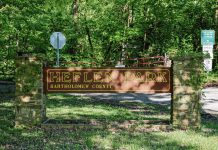STORY BY BARNEY QUICK
For The Republic
At 83, Fonis Payne remains a busy man, much as he has been throughout his life. Five bouts with various types of cancer, the most recent still ongoing, haven’t appreciably affected his pace.
He frequently drives 14 hours to Victoria, Texas, where he and his wife Margaret live part of the year. Until recently, they ran a property-management business there. He’s a proactive partner with his doctors regarding his health; his research into various conditions he’s experienced is extensive.
His working life has been long and varied. He started as an automotive machinist, building racing engines and industrial engines. He then advanced in the insurance field and related areas, working as a claims manager, a partner in an agency, a safety manager for a trucking company and an investigator for a plaintiff law firm.
Cancer was a factor in Payne’s life before he had it himself. His first wife died from ovarian cancer at age 38 after a lengthy ordeal. He later married Margaret.
[sc:text-divider text-divider-title=”Story continues below gallery” ]
Click here to purchase photos from this galleryHe’d dated Margaret in high school. In fact, their families had known each other since the 1920s. At the 25th reunion of their graduating class, they reconnected. They’ve now been married 40 years.
Payne’s outlook has always been upbeat, but he told her when they married in 1976 that if they had 20 years together he would consider it a bonus. The time span between then and the occurrence of his first cancer was mere months shy of that.
“We don’t let anything affect our lifestyle … As for what’s next, who knows? Whatever it is, I’ll be there to hold his hand and remind him that it’s just another bump in our road.”
—Margaret Payne
In 1995, he took a morning off from work to get a colonoscopy at Columbus Regional Hospital. “I went in at 6. At 10, my doctor woke me up to tell me I had a large colon cancer,” Payne said.
“My first thought was the date,” Margaret said. “It was 19 years and a couple of months from the time he’d mentioned in his remark when we got married.”
Treatment involved surgery and six months of chemotherapy, at a rate of a week per month.
“I’d call the chief of oncology nursing and tell her I was on my way,” he says. “The treatments took about 12 minutes. Afterwards, I’d have a copper taste in my mouth, so I’d get an iced tea. I’d be back at my office in about half an hour.”
About a year after his surgery, his surgeon told him he was in extended remission. He was working for the law firm, taking aerial photographs and videos, contacting witnesses, and conducting stakeouts and negotiations. He also performed all the maintenance on the rental properties he and Margaret owned in Texas.
In April 2000, he was diagnosed with prostate cancer, resulting in 38 radiation treatments.
“The level of my PSA (prostate-specific antigen, a protein produced by the prostate’s cells) never really did go down,” Payne said.
Cancer is a cause of a rise in PSA level.
Four years later, the condition returned. Payne underwent a surgical biopsy at MD Anderson Cancer Center in Houston.
He returned to Columbus Regional and consulted with the radiation oncologist who’d treated him in 2000. That doctor told him about a friend who specialized in secondary prostate cancer.
That friend, Dr. Arve Gillette, practiced at Community Hospital East in Indianapolis, and had developed a new treatment based on his study of biothermy. Payne became the first patient in the United States to undergo the procedure. It involved a radiation dose 10,000 times more powerful than what is standard, delivered in seeds that leave the patient afterward.
“A nuclear physicist was involved,” Payne said. “In between the doses, the targeted area was heated to 104 degrees with small wires. The heat would hit the cobalt radiation and explode it into the system.”
There were two rounds of treatment, spaced a month apart. Payne wore a special T-shirt for the occasions. It was embroidered with “GP1,” indicating that he was Dr. Gillette’s first guinea pig.
“My PSA level went from over nine to less than one,” he said.
Gillette now practices in Texas, but stays in touch with Payne, who has fielded calls from all over the world about the procedure.
So he’d prevailed over cancer three times. Then, four years ago, he noticed a sty on his lower left eyelid. An eye surgeon diagnosed it as basal cell carcinoma, and determined it was widespread.
He had the cancer removed, along with surrounding tissue, at the St. Vincent Outpatient Center in Indianapolis.
“I followed through for a couple of years and then my doctor released me,” Payne said.
Since then, Payne has had 36 incidents of skin cancer. He gets them treated by a dermatologist and applies a salve.
Does it take some time out of his daily life to deal with it? Certainly, but it’s far from the dominant factor.
“We don’t let anything affect our lifestyle,” Margaret Payne said. “As for what’s next, who knows? Whatever it is, I’ll be there to hold his hand and remind him that it’s just another bump in our road.”
[sc:pullout-title pullout-title=”Fonis Payne” ][sc:pullout-text-begin]
AGE: 83
TYPES OF CANCER: Colon, diagnosed December 1995; prostate, diagnosed April 2000 and again April 2004; basal cell carcinoma, diagnosed 2012; skin cancers, diagnosed 2015.
OCCUPATIONS: Held various positions in the insurance industry, property management.
FAMILY: Wife, Margaret; children, Susan, Brent, Brian, Lynn.
ADVICE: “You have the opportunity to give yourself to people. Everyone’s days are limited, whether they know it or not.”
[sc:pullout-text-end]




